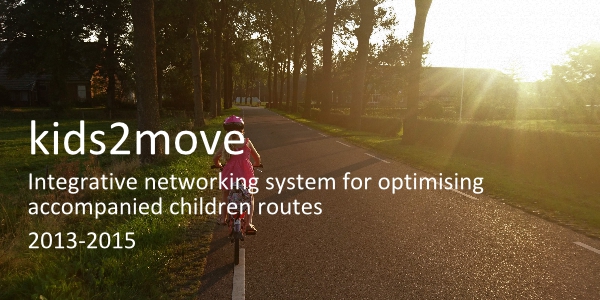kids2move

Already in earliest childhood, transport behaviour is influenced by the role- model effect of the personal environment. Through the development of an integrative networking system for the optimisation of accompanied child routes, the goal of a sustainable influence on awareness and decision-making processes in the choice of means of transport is achieved. This breaks down rigid patterns in motorised private transport and enables new patterns of traffic behaviour.
Client: bmvit, mobility of the future. 2. invitation to tender
Duration: April 2014 to March 2016 (24 months)
Project partners: University of Natural Resources and Applied Life Sciences Vienna, FACTUM Chaloupka & Risser OG, SHS GesbR, pn-venture OG, Verein Kindergruppe Spielzimmer 5 Sinne
Project description:
The starting point for the kids2move project can be traced back to two important aspects or circumstances: I) Transport behaviour expressed in essence by the choice of means of transport, is already influenced or shaped in earliest childhood. Here, the role-model effect of the personal environment and in particular that of parents and grandparents is of great importance. Routine routes such as kindergarten and elementary school in particular shape access to mobility and concrete-mobility behaviour already in the first years of life. II) A large proportion of these accompanied routes are still taken care of with children in the MIT. One third of the accompanied routes to the kindergarten are covered by auto. It can be observed that the occupancy rate of passenger autos in the aforementioned travel purpose is very low. After the parents have brought the children to the kindergarten, the auto is usually only occupied by one person. Thus two central problems and challenges can be derived as a basis for the kids2move project: I) The proportion of accompanied routes for children in the MIT is still relatively high and II) The occupancy rate of autos within the framework of accompanied routes is relatively low. This results in a great potential for modal shift to the environmental network or for increasing efficiency in the MIT and thus in total, a reduction in the negative effects of transport.
One goal of the kids2move project was to sustainably influence awareness and decision-making processes in the choice of means of transport for accompanied children routes in order to break rigid patterns in motorised individual travel and to enable new travel-behaviour patterns in the context of accompanied children routes. This change in behaviour should have an impact on overall mobility behaviour and thus promote a new understanding of mobility (towards more sustainable mobility). It was therefore the central objective to question well-established patterns especially in the case of recurring routine routes such as accompanied children routes and to offer new options thus promoting sustainable mobility behaviour. Another central goal was to identify individual options for “active mobility” within the framework of accompanied children routes in order to tap previously untapped potential and thus achieve the positive effects of “active mobility”. Another aspect is to offer children “equal opportunities” in getting to know and use different means of transport and (especially women) to make use of time resources.
Within the kids2move project, the content, legal and economic framework for the tool for the coordination of accompanied children routes was developed. National and international practical examples were also analysed and evaluated. It turned out that there is no comparable system either nationally or internationally. In a further work step, the theoretical travel potential was developed via model calculation. This was the basis for estimating the (economic) potential of the networking tool. Building on the inter- and transdisciplinary requirements, the tool was designed, prototypically implemented, subjected to a broad field test, evaluated and the need for further development derived and defined. In a final step, operator models were developed and an economic view was taken. As a conclusion from kids2move it can be stated that the potential of the networking tool for traffic avoidance and awareness raising is extremely high.
Contact: DI Dr. Alex Neumann, MA MSc
